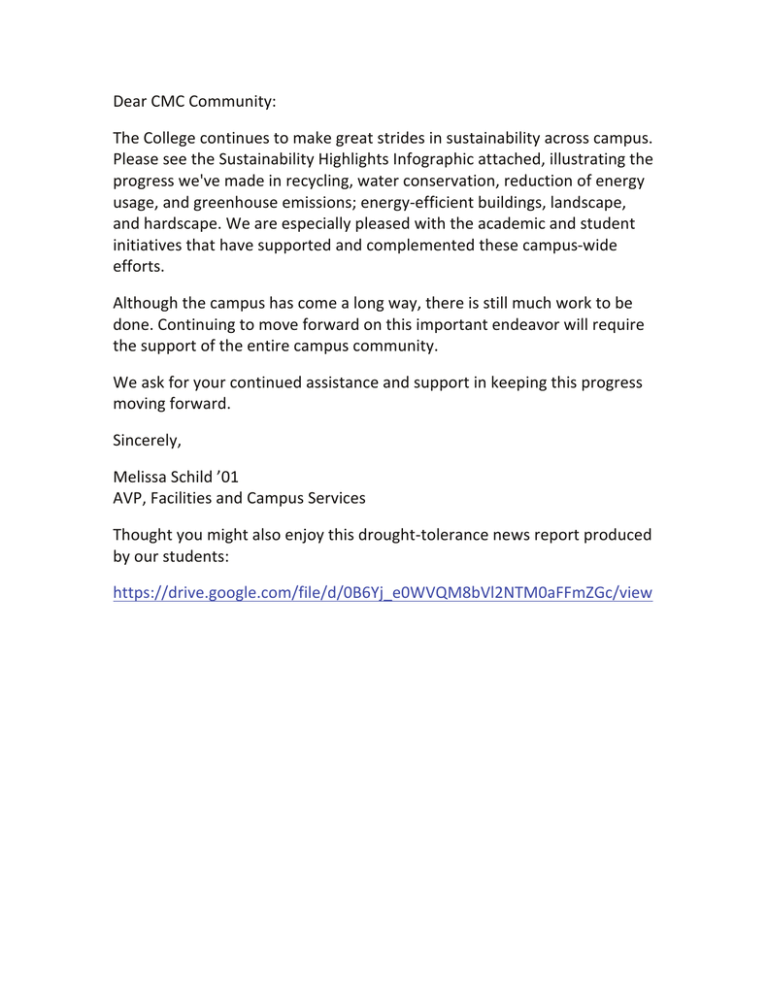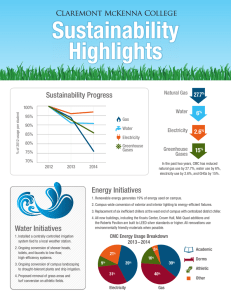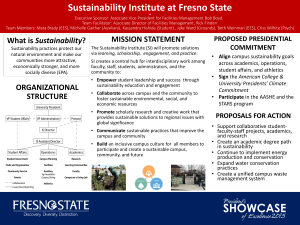Document 13245918
advertisement

Dear CMC Community: The College continues to make great strides in sustainability across campus. Please see the Sustainability Highlights Infographic attached, illustrating the progress we've made in recycling, water conservation, reduction of energy usage, and greenhouse emissions; energy-­‐efficient buildings, landscape, and hardscape. We are especially pleased with the academic and student initiatives that have supported and complemented these campus-­‐wide efforts. Although the campus has come a long way, there is still much work to be done. Continuing to move forward on this important endeavor will require the support of the entire campus community. We ask for your continued assistance and support in keeping this progress moving forward. Sincerely, Melissa Schild ’01 AVP, Facilities and Campus Services Thought you might also enjoy this drought-­‐tolerance news report produced by our students: https://drive.google.com/file/d/0B6Yj_e0WVQM8bVl2NTM0aFFmZGc/view Sustainability Highlights Natural Gas Sustainability Progress % of 2012 usage per student 100% Water 95% Gas 90% Water 85% Greenhouse Gases 75% 70% 2012 2013 6% Electricity 2.6% Greenhouse Gases 15% Electricity 80% 27.7% In the past two years, CMC has reduced natural gas use by 27.7%, water use by 6%, electricity use by 2.6%, and GHGs by 15%. 2014 Energy Initiatives 1. Renewable energy generates 19% of energy used on campus. 2. Campus-wide conversion of exterior and interior lighting to energy-efficient fixtures. 3. Replacement of six inefficient chillers at the west end of campus with centralized district chiller. Water Initiatives 4. All new buildings, including the Kravis Center, Crown Hall, Mid-Quad additions and the Roberts Pavilion are built to LEED silver standards or higher. All renovations use environmentally friendly materials when possible. 1. Installed a centrally controlled irrigation system tied to a local weather station. CMC Energy Usage Breakdown 2013 – 2014 2. Ongoing conversion of shower heads, toilets, and faucets to low-flow, high-efficiency systems. 21% 3. Ongoing conversion of campus landscaping to drought-tolerant plants and drip irrigation. 4. Proposed removal of grass areas and turf conversion on athletic fields. 9 39 % Academic 5% 16% 39% % Dorms Athletic 31% Electricity 40% Gas Other Waste Initiatives 1. Dehydrating food decomposers allow for approximately 85% of total food waste to be reused as compost on campus. In 2014, 2. Cardboard balers outside the Collins dining hall promote the recycling of all cardboard box waste. 129 lbs each 3. Receptacles for recyclable materials are installed around campus and in dorms, together with posters explaining what materials can be recycled. CMC students each produced 129 pounds of refuse. Student Involvement Claremont McKenna College has an environmental major and two leading environmental sustainability groups, both run mainly by students of all class years. Students have also made a concerted effort in recent years to minimize energy and water use by turning off electronics and lights in dorm rooms, and minimizing water use in bathrooms. Roberts Environmental Center (REC) The principal goal of the REC is to involve students in real-world environmental issues and to train them to analyze the issues from a broad perspective, taking science, economics, and policy into consideration. The center is comprised of teams of student analysts working on issues related to education, NGOs, governance, and local sustainability. REC students are currently working on large-scale projects such as the Georgetown University Energy Prize, proposal of a blackwater reclamation plant for the Claremont Colleges, teaching a sustainability curriculum for elementary students in the Claremont Unified School District, contract consulting with PaintCare Inc., and conducting research on several different environmental issues. Sustainable Students Promoting Environmental Action and Responsibility (SSPEAR) Environmental Analysis, Environmental, Economics and Politics (EEP) Majors SSPEAR has engaged students every year in a number of environmental activities on campus. SSPEAR, in the past couple years, has assisted in the promotion of energy efficiency competitions, assigned dorm eco-representatives, and promoted sustainability in the local community. This year, SSPEAR helped CMC win the 5C Power Down in 2015, a competition between campuses to see which campus can have the greatest reduction in energy usage. CMC has prioritized climate change and sustainability in academic programs for all students in curriculum and research activities. The Claremont Colleges were awarded a $1.5 million grant from the Andrew W. Mellon Foundation to further establish and develop the Environmental Analysis major. This includes expanding the program to cover all of the Claremont Colleges, hiring new faculty in areas of particular interest (including climate science), grants for student research, and the development of new curriculum. Our sustainability efforts help us become better stewards of the earth’s resources.


